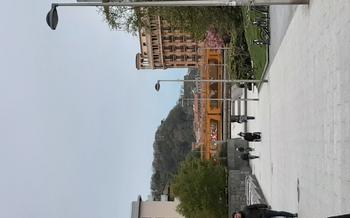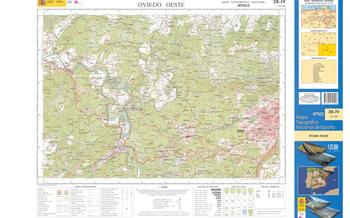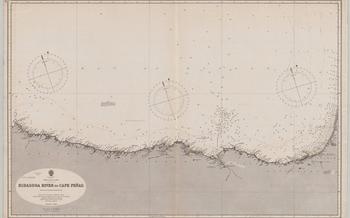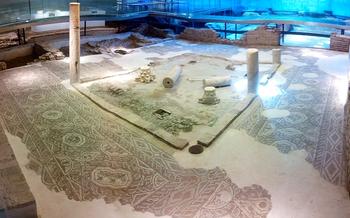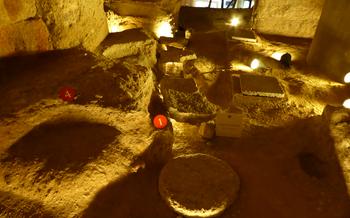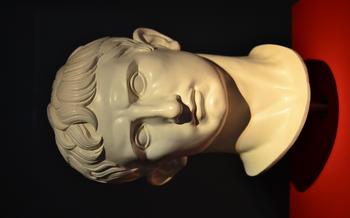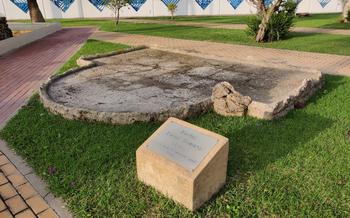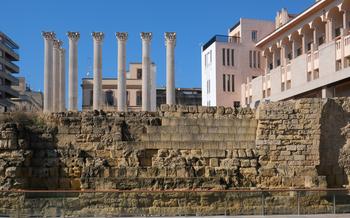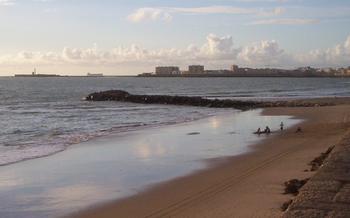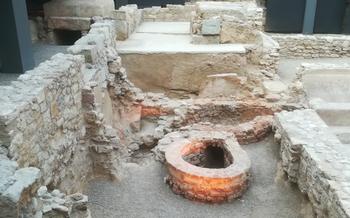
Museo Romano Oiasso
- Exploring the Roman Ruins
- Oiasso's Historical Context
- The Museum's Collections
- Everyday Life in Roman Oiasso
- The Roman Baths: A Place of Relaxation
- Religious Beliefs and Practices
- Interactive Exhibits for a Deeper Understanding
- Unveiling the History of Oiasso
- Museum Tours and Educational Programs
- Accessibility and Facilities
- Combining History with Nature
- Events and Exhibitions
Exploring the Roman Ruins
The excavations at Oiasso have uncovered a wealth of Roman remains, providing a glimpse into the daily lives of the ancient inhabitants. Visitors can explore the foundations of several buildings, including a temple, a market, and a necropolis. The most impressive structure is the Roman baths, which feature well-preserved pools, changing rooms, and a heating system.
The excavated artifacts, such as ceramics, coins, and tools, offer valuable insights into the economy and trade activities of Roman Oiasso. These artifacts are displayed in the museum's collection, providing a comprehensive understanding of the Roman presence in the region.
Oiasso's Historical Context
The Roman presence in the Basque Country dates back to the 1st century BC, when they conquered the region and established the province of Hispania Tarraconensis. Oiasso, strategically located on the coast, played a crucial role in the Romanization of the area.
Thanks to its natural harbor and fertile lands, Oiasso flourished as a significant trading port. It served as a gateway for the exchange of goods between the Roman Empire and the local Basque population. Oiasso's favorable location allowed for the import and export of various commodities, including wine, olive oil, ceramics, and metalwork.
The city's strategic position also made it a vital military outpost for the Romans. They constructed a fortress and garrisoned troops to maintain control over the region and protect the trade routes. Oiasso's role as a military stronghold contributed to its growth and prosperity during the Roman period.
The Museum's Collections
The Museo Romano Oiasso houses an impressive collection of artifacts and exhibits that bring to life the history and culture of Roman Oiasso and the surrounding region. These artifacts, discovered through excavations and archaeological research, offer valuable insights into the daily lives, beliefs, and practices of the ancient Roman inhabitants.
Among the museum's highlights are finely preserved pottery, tools, weapons, jewelry, and building materials. These objects provide a glimpse into the domestic and economic activities of the Roman Oiasso community. Visitors can admire intricate ceramic vessels, bronze and iron tools, and a variety of weapons used for hunting, defense, and warfare. Jewelry items, such as brooches, bracelets, and rings, showcase the craftsmanship and artistry of the Roman people.
Interactive displays and multimedia experiences further enhance the museum experience. Visitors can engage with touchscreens and virtual reality exhibits that bring Roman history to life. These interactive elements provide a unique and immersive way to explore the museum's collection and gain a deeper understanding of the Roman presence in the region.
Everyday Life in Roman Oiasso
The Museo Romano Oiasso offers a glimpse into the domestic life, economy, and social structure of Roman Oiasso. Through artifacts and displays, visitors can learn about the daily routines, occupations, and social interactions of the city's inhabitants.
The museum showcases various household objects, such as cookware, utensils, and ceramic vessels, providing insights into the culinary practices and dining habits of the Romans. Visitors can also explore tools and implements related to different professions, such as farming, fishing, and metalworking, shedding light on the economic activities that sustained the city.
The social structure of Roman Oiasso is illuminated through artifacts that reveal the hierarchy and social stratification within the community. Visitors can examine items related to religious practices, such as votive offerings and funerary objects, gaining an understanding of the spiritual beliefs and rituals that shaped the lives of the Oiasso Romans.
Overall, the museum offers a comprehensive exploration of everyday life in Roman Oiasso, allowing visitors to immerse themselves in the daily realities and social dynamics of this ancient Roman city.
The Roman Baths: A Place of Relaxation
In Roman culture, baths were not merely places for hygiene but also significant social and cultural hubs. The Museo Romano Oiasso features the remains of a Roman bath complex, offering a glimpse into the bathing practices and rituals of the past.
Uncover the significance of these baths in the Roman way of life, exploring their architectural features and learning about the various functions they served. Discover the frigidarium, tepidarium, and caldarium – rooms dedicated to cold, warm, and hot baths, respectively – and appreciate the intricate heating systems that maintained the desired temperatures.
Visualize the bustling atmosphere of these baths as Romans from all walks of life gathered to socialize, relax, and rejuvenate. Imagine the steam rising from the pools, the sound of laughter and conversation filling the air, and the sense of well-being that permeated these spaces.
Through the preserved remains of the baths and the museum's informative displays, you'll gain a deeper understanding of the importance of bathing in Roman society and experience a tangible connection to the daily lives of Oiasso's ancient inhabitants.
Religious Beliefs and Practices
Oiasso's Roman inhabitants held diverse religious beliefs and practices that provide insight into their spiritual world. Among the artifacts discovered at the Museo Romano Oiasso are several related to Roman deities, offering glimpses into their pantheon and religious rituals.
Statues, busts, and inscriptions dedicated to various gods and goddesses have been unearthed, shedding light on the religious landscape of the city. Visitors can admire representations of Jupiter, the king of the gods, as well as other deities such as Juno, Minerva, and Apollo. These artifacts provide tangible evidence of the religious devotion and beliefs of the Roman people who once called Oiasso home.
The museum also houses a collection of artifacts related to funerary customs and rituals. Inscribed tombstones, funerary stelae, and cinerary urns offer insights into how the ancient Romans commemorated their deceased loved ones. These artifacts provide a glimpse into the beliefs and practices surrounding death and the afterlife in Roman culture.
Exploring these religious artifacts and remnants allows visitors to gain a deeper understanding of the spiritual beliefs and practices that shaped the lives of the Roman inhabitants of Oiasso.
Interactive Exhibits for a Deeper Understanding
The Museo Romano Oiasso takes visitor engagement to the next level with its interactive exhibits. Multimedia presentations bring history to life, allowing visitors to experience Oiasso's past in a vibrant and immersive way. Interactive displays invite visitors to engage with artifacts, explore virtual reality reconstructions, and even try their hand at Roman-era activities. These interactive elements cater to visitors of all ages, making the museum a fun and educational experience for families and groups alike. Whether you're a history buff or simply curious about Roman culture, the interactive exhibits at the Museo Romano Oiasso offer a deeper and more engaging way to uncover the secrets of Oiasso's past.
Unveiling the History of Oiasso
The journey through time that the Museo Romano Oiasso offers is far from over. Archaeological excavations continue to unveil the secrets of this ancient city, bringing to light new insights and discoveries. Ongoing research by archaeologists, historians, and experts in various fields contribute to a deeper understanding of Roman Oiasso and its significance. Each new artifact, structure, or piece of information adds to the rich tapestry of the city's history, revealing more about its daily life, economy, trade, and cultural practices.
The museum's commitment to ongoing research ensures that the story of Roman Oiasso remains vibrant and dynamic. Through collaborations with universities, research institutions, and international experts, the museum continues to contribute to the broader field of Roman archaeology and history. These ongoing efforts not only enhance the museum's exhibits but also provide valuable insights for scholars and enthusiasts alike, ensuring that the legacy of Oiasso continues to inspire and captivate future generations.
Museum Tours and Educational Programs
The Museo Romano Oiasso offers guided tours to enhance your experience and provide deeper insights into the history of Oiasso and the Roman Empire. Knowledgeable guides will take you through the museum's exhibits, explaining the significance of artifacts and providing historical context. Tours are available in multiple languages, ensuring accessibility for visitors from different backgrounds.
In addition to guided tours, the museum offers educational programs designed for families and groups. These programs include interactive workshops and activities that bring Roman history to life. Children can participate in hands-on activities, such as creating mosaics or dressing up in Roman costumes, while learning about the daily lives of the ancient Romans. These programs are an excellent way to engage younger visitors and make their museum experience more memorable.
Accessibility and Facilities
The Museo Romano Oiasso is committed to providing an accessible and inclusive environment for all visitors. Wheelchair users and visitors with limited mobility can easily navigate the museum's ground floor, where most of the exhibits are displayed. Ramps and elevators ensure that everyone can fully explore the museum's treasures.
For those seeking further information or assistance, the museum's friendly and knowledgeable staff is always ready to help. Information desks are strategically placed to provide guidance and answer any questions visitors may have. Multilingual support is available to cater to international visitors and ensure a smooth and enjoyable experience for all.
Combining History with Nature
Oiasso's rich history and cultural heritage are beautifully complemented by its stunning natural surroundings. Visitors to the Museo Romano Oiasso can venture beyond the museum walls and explore the picturesque landscapes that embrace this ancient Roman city. The verdant hills, lush forests, and sparkling waters of the Oiasso region offer a myriad of opportunities for outdoor enthusiasts and nature lovers.
Take advantage of the well-maintained hiking trails that wind through the countryside, leading you to breathtaking viewpoints and hidden gems. Immerse yourself in the tranquility of the lush forests, where the sounds of birdsong and the rustling leaves create a serene atmosphere. Discover the unspoiled beauty of the coastline, where secluded beaches and rugged cliffs await your exploration.
For those seeking a more active experience, the region offers excellent opportunities for mountain biking, cycling, and water sports. Embark on a thrilling mountain bike adventure through the challenging terrains, or glide along the scenic bike paths that meander through the countryside. Take to the waters and enjoy a refreshing swim, kayak, or stand-up paddleboarding session in the pristine waters of the Oiasso coastline.
Whether you prefer leisurely walks, invigorating bike rides, or adrenaline-pumping water sports, the natural surroundings of Oiasso provide a perfect balance to the historical and cultural immersion offered by the Museo Romano Oiasso. Embrace the opportunity to combine your exploration of ancient Roman history with the beauty and tranquility of the natural world, creating a truly unforgettable experience.
Events and Exhibitions
The Museo Romano Oiasso regularly hosts temporary exhibitions and cultural events that delve deeper into Roman history and culture. These events provide a dynamic and engaging way to learn more about the ancient world and its enduring influence. Visitors can participate in workshops, lectures, guided tours with specialized themes, and hands-on activities designed to enhance their understanding of Oiasso's past.
One of the highlights of the museum's events calendar is the annual Roman Festival, held during the summer months. This lively event transports visitors back in time with reenactments, demonstrations of Roman crafts and cuisine, and performances by traditional musicians and dancers. It's an immersive experience that brings the history of Oiasso to life and allows visitors to connect with the ancient Roman world in a unique and unforgettable way.
